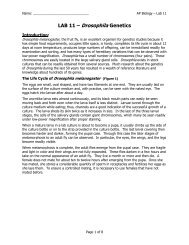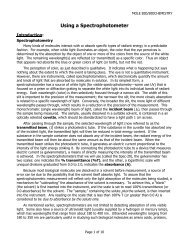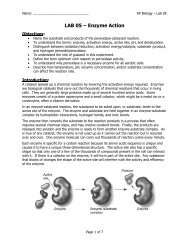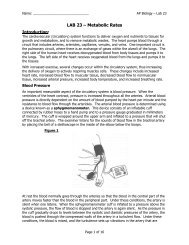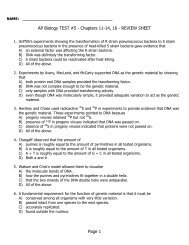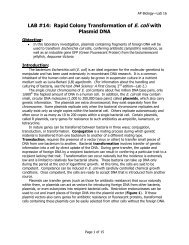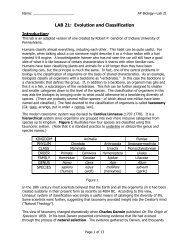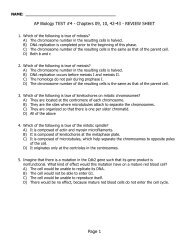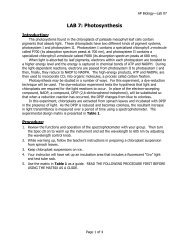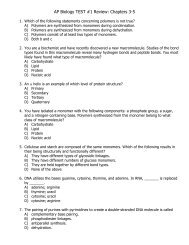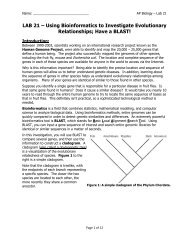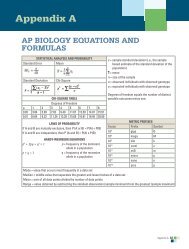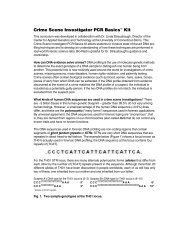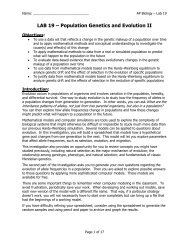AP Lab 02 - Biology Lab Skills
AP Lab 02 - Biology Lab Skills
AP Lab 02 - Biology Lab Skills
Create successful ePaper yourself
Turn your PDF publications into a flip-book with our unique Google optimized e-Paper software.
Name: ______________________________ <strong>AP</strong> <strong>Biology</strong> – <strong>Lab</strong> <strong>02</strong><br />
‣ Do no operate any laboratory equipment until you have been instructed in its use.<br />
‣ Do not perform unauthorized experiments.<br />
‣ Keep your work area neat, clean, and organized.<br />
‣ Read and understand the experiments you will be doing before coming to the<br />
laboratory.<br />
Follow the procedures set forth by the laboratory manual.<br />
‣ Know the location of emergency equipment:<br />
first aid kit<br />
eyewash bottle<br />
fire extinguisher<br />
showers<br />
fire blanket<br />
‣ Report all accidents to your laboratory instructor immediately.<br />
‣ Discard cracked or broken glass only in the broken glass containers.<br />
‣ Report all unsafe conditions to your instructor.<br />
‣ Clean your work area and glassware and wash your hands before leaving the laboratory.<br />
PART I – Measurement, Accuracy, Precision, and Graphical Analysis<br />
Measurement plays a particularly large role in science. In their studies, scientists gather data,<br />
and to do this they use measurements. Scientists measure the concentration of gases in the<br />
atmosphere, the growth of organisms under varying conditions, the rate of biochemical<br />
reactions, the distance of stars from the earth, and an innumerable number of other things. As<br />
measurements form the basis of scientific inquiry, they are deserving of in-depth analysis in lab.<br />
<strong>Biology</strong> students, as part of their laboratory experience, will be asked to make measurements or<br />
observations during the course of their investigations. These may be either qualitative or<br />
quantitative. A qualitative measurement/observation describes a characteristic and is not<br />
numerical; a quantitative measurement/observation is numerical. Scientific observations<br />
are usually made as quantitative as possible so that they are easier to evaluate. For example, if<br />
you were trying to find the insect with the world's largest wingspan, quantitative observations<br />
are needed. An insect's wingspan may be qualitatively described as huge, but a quantitative<br />
description of an insect‘s wing span as 20 centimeters would be much more useful for this<br />
project.<br />
In a scientific experiment, the investigator examines the effects of variations in the independent<br />
variable on the dependent variable through measurements. For example, let's assume a<br />
biologist is studying the effect of temperature on plant growth. She sets up several different<br />
temperature conditions, and grows groups of plants from seedlings in each condition. When<br />
the experiment ends, she must compare plant growth in the plants from different temperatures.<br />
But how should she do this? Should she just look at the plants and decide which grew the<br />
best? Should she pick up the plants and "feel" which ones have the greatest mass? Of course<br />
not… She would use some sort of quantitative measurement, such as measuring the height<br />
of each plant's stem in centimeters or determining the total plant biomass in grams. Whichever<br />
measurement she chooses, she would need to utilize an instrument to make it.<br />
Take a minute and look around you at the variety of objects surrounding you. There are<br />
probably a few pens or pencils, a notebook or two, and maybe assorted glassware. While you<br />
may be able to easily distinguish the differences between some objects (e.g., your notebook is<br />
longer than your pen), other differences are more difficult to discern. You may not be able to<br />
easily determine, for example, whether your computer keyboard or your course textbook has<br />
greater mass. Even when we can distinguish differences, it is not always easy to determine the<br />
Page 2 of 40




